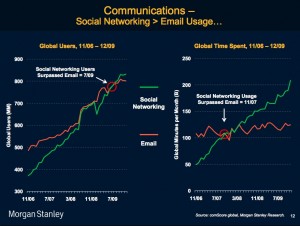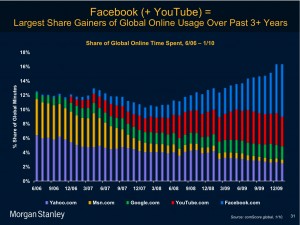Ready or not, social media is taking off. You’ve been thinking that everyone and their mother (literally) is on Facebook. You’ve thought that maybe you’re imagining it. Nope. You’re not. A few days ago I showed you how Facebook has become the king of all social networking sites. Now I’m thinking we should consider email dead — much like my death declarations of the Post Office, not dead today, but going to be dead some time in the near future.
 Fred Wilson, a big-time venture capitalist, points to a Morgan Stanley Internet Trends study containing this chart:
Fred Wilson, a big-time venture capitalist, points to a Morgan Stanley Internet Trends study containing this chart:
Notice how Social Media users and usage has surpassed email. Hmmm…I think that means we need to be sure we have complementary strategies to the “good old email blast.”
Here’s another fun chart from the same Morgan Stanley report:

Yikes. Look at the growth of Facebook and YouTube. As I said earlier this week, sit on the sidelines at your peril. Don’t wait for the perfect plan. Jump in. No one has it all figured out but you can figure out how you and your organization are going to use these great tools. Remember, none are perfect. None are silver bullets. And no regular charity is really raising much money directly on Facebook. BUT you can support an integrated strategy with these powerful tools.
So tell me, were you as surprised as I was about these charts? What are you thinking about your organization’s use of Facebook. And, if you’re not on Facebook (and I know you’re out there) tell us why not. I’d love to have a dialog about it.
What do you think?
st

Steve Thomas
Partner, Oneicity
(nod to Business Insider.com Chart of the Day)


8 thoughts on “strategy: social media trumps email”
Hey Steve, this does not surprise me in the least. We have been harnessing the power of Social Media as a marketing tool and it has been paying dividends! Especially considering that it is FREE!
A direct msg on Twitter is the new “cold call”
Why is it so effective?
Because it HAS to be CONCISE, forcing us to get straight to the point.
Because it is LESS INVASIVE than a long winded VM that gets deleted before the end or an email that comes in distracting focus and frustrating the prospect.
And because it is FUN! A “follow” or “direct msg” on Twitter give us the same feeling we used to get a decade ago when we heard “you’ve got mail”!
I’m sending this post to my clients this morning. These largely for-profit players in the housing industry still resist the message of Social Media. (Could it be the average age of these clients is north of their mid 40s?). Keep up the evangelizing for the movement that make media person— a two way conversation with our friends, our customers, our donors our supporters!
@Al–Thanks a ton Al. In your space, you’re da Man! So it means a lot for you to agree so strongly. It is an interesting world full of changes and possibilities. I’m glad the housing industry has rebels like you to help them find success.
Oh and Al, point your clients to the fact that the fastest growing age segments in social media are the 40+ age groups…just saying.
st
@Steve — Good thoughts. And you’re right.
A couple questions, how do we keep our social media activities from becoming spam (I have a thought or two about it but I know you’re a thinker)? And email is typically free too, so what’s the difference in social media free and email free?
Glad you jumped in the conversation!
st
Good grief, this is awesome stuff. Sure, the idea of losing email is scary at first, but I gotta say, we’re starting to think in this direction for our own business – even to the point of just dropping our internal email business database.
Regarding Steve’s response to Steve, the difference is all in the value. Our little home state of New Hampshire was home to the spam kings, where a 1-in-43,000 response rate was profitable. Social media doesn’t allow for that, because it raises another barrier to communication entry. Once given, it can easily be taken away, no spam filter necessary.
Even if spammers figure out how to write programs that hit the “Send so-and-so a message” links on Facebook en masse, Facebook is much more likely to attack that problem head-on than, say, your garden-variety email service provider.
And on a synchronistic side note, I posted a video earlier this week on our Facebook Fan Page about how OK Go’s video views dropped 90% on YouTube when their record label wouldn’t allow their videos to be shared or embedded. Their lead singer wrote a New York Times op-ed piece about it, and I realized that he said nothing about sharing the video via email. Email’s become completely irrelevant to the sharing/viral conversation. Crazy world we’re living in. 🙂
Thanks for this great post, Steve. (P.S. I like your writing style, too!)
@Allen–thanks for your encouragement and comments. You are so right that social media doesn’t tolerate spam. The social media community, participants and providers, root out and kill anything that even looks like spam. Great thought.
It is a crazy world, which may explain why it makes sense to me :).
Thanks for dropping, you guys are our role models of a couple working together.
st
I couldn’t resist not jumping in on this conversation. I’m curious if the rise of social media doesn’t naturally coincide with an individual’s desire for authentic relationships?
If we think about the Internet from an historical aspect…
1) We have email – its a great way to reach out and touch people we don’t have the opportunity to communicate with regularly (buddies from college, long lost loves, and more). With email its the next best thing since writing a letter, who wouldn’t love the ability to click a button and immediately know that your deepest thoughts on the subject of peanut butter and bean sprout sandwiches are being shared with your friends?
2) Then comes Instant Messaging – WOW! No longer do I have to sit by my computer and wait for the infamous “You’ve Got Mail!” when you can be typing live back and forth with each other. This is super exciting, however you both have to be online at the same time.
3) Now jump forward and we have social media tools such as Facebook and Twitter where I can peer into your life knowing the type of coffee you had this morning while sitting in twenty miles of rush-hour traffic. We love that we can see what our friends are up to and feel like we have reconnected. Its instantaneous and its on our terms.
In many ways, social media affords us the first opportunity on the Internet to build authentic relationships around our schedule but to also filter the type of information we collect. So if I really want to hear about the farm you are building, GREAT! However, if I don’t care about your Mafia War – BLOCK!
Spam tends to get labeled as any item we didn’t solicit nor does it bring us any value to me. So are we already getting social media spam – a big, hand raising, amen, Y E S!!
This is the struggle with businesses and non-profits being apart of social media. What are they are doing to bring value to my life. While I’ll be in the line to support a really great cause, help me Mr. Non-Profit to understand how I’m impacting lives and brining about change. I want to make a difference. Don’t just tell me your need for money. Help me to understand the issues and how I can be change element where I live.
Organizations, in my own humble opinion, that have identified who their tribes (see Seth Godin) are and how they are empowered to make an impact have created a social media difference. The best example I can think of is Harley Davidson – if you look at their Facebook site they have fans sharing stories, pictures, advice and more to other Harley owners and Harley want-to-be’s. Now if we could harness that same energy toward social causes, think how impactful non-profits could be.
@Brandon–great stuff! Hadn’t thought about this as a progression the way you lay it out. I do completely believe that we are seeing a reflection of our desire/need to connect.
The identification of tribes (Seth) is key. Maybe the tribe gathers because of an understanding of what the NPO does and how the NPO is connected to them–chickens and eggs I suspect.
Figuring out what happens in the donor’s heart is critically important. I believe, and some will disagree, that the connection must be deeper than the “it’s-good-for-you-to-give” connection. That connection isn’t unique to each NPO nor is it always as strong as some would have you believe.
Harley does do a great job of connecting with people’s desires. They really don’t sell motorcycles. They sell an ideal that is delivered when you get the bike. Thanks for the Harley thought, now to figure out how to relate it to NPOs.
So glad you stopped by and stayed awhile.
st
Comments are closed.